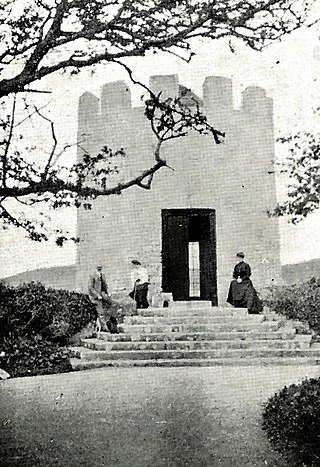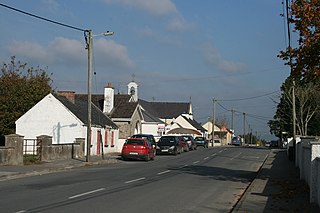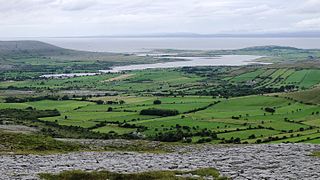
Irish round towers are early mediaeval stone towers of a type found mainly in Ireland, with two in Scotland and one on the Isle of Man. As their name Cloigtheach indicates, they were originally bell towers, though they may have been later used for additional purposes.

Oranmore is a town near the city of Galway in County Galway, Ireland. It is also the name of the civil parish and Roman Catholic parish in which the town lies.

Millstreet is a town in north County Cork, Ireland. As of the 2016 census, it had a population of 1,555.

Great Island is an island in Cork Harbour, at the mouth of the River Lee and close to the city of Cork, Ireland. The largest town on the island is Cobh. The island's economic and social history has historically been linked to the naval, ship-building, and shipping activities in the town's environs.

Aughagower or Aghagower is a small village in rural County Mayo in western Ireland. It is located about 6 km from Westport. Aughagower has around 40 houses, 1 pub and a shop, with a clear view of Croagh Patrick from Reek View. It also forms the centre of a parish of the same name which covers an area of 86.1 square miles. The village is known for its links to Saint Patrick and Tóchar Phádraig, the pilgrimage route from Ballintubber Abbey to Croagh Patrick.

The twin villages of Ballineen and Enniskeane, or Enniskean, in County Cork in Ireland are 43 km (26.72 mi) southwest of Cork City, on the R586 road. The linear settlement lies on the River Bandon between Bandon and Dunmanway. The combined settlement is designated as a 'key village' by Cork County Council for planning purposes and, as of the 2016 census, had a population of 692 people.

Douglas is a suburb, with a village core, in Cork city, Ireland. Douglas is also the name of the townland, Roman Catholic parish, Church of Ireland parish and civil parish in which it is contained.

Durrus is a village and civil parish in West Cork in Ireland. It is situated ten kilometres (6 mi) from Bantry in County Cork, at the head of the Sheep's Head and the Mizen Head peninsulas.
Lyre is a townland and small village in the civil parish of Clonmeen, barony of Duhallow, northwest County Cork, Ireland. It is approximately 3 km from the village of Nad. Lyre is within the Cork North-West Dáil constituency.

Carrigaphooca Castle is a ruined five storey rectangular tower house situated on a steep-sided rock overlooking the River Sullane. It is located 6 km west of Macroom, County Cork, Ireland, in an area once known as Gleann na n-Dearg. The tower dominates the landscape of Lissacresig (Fairyland) in Clondrohid, and Lower Shanballyshane, in Kilnamartyra. Carrigaphooca is made of sandstone and limestone and was built as a defensive tower by the MacCarthys of Muskerry in the early 15th century.

Rostellan is a civil parish, townland and village in the historical Barony of Imokilly, County Cork, Ireland. An electoral division of the same name forms part of the Cork East Dáil constituency. For census purposes, the village of Rostellan is combined with the neighbouring villages of Farsid and Aghada. As of the 2011 census, the combined settlement of Aghada-Farsid-Rostellan had a population of 1,015 people.

Gortnahoe, also known as Gortnahoo, is a village in County Tipperary, Ireland. It is located on the R689 regional road 6 km (3.7 mi) south of Urlingford, County Kilkenny. It is 3 km (1.9 mi) southeast of the N8 Dublin - Cork road. Gortnahoe, pronounced "Gurt/na/hoo" by the locals, is part of the parish of Gortnahoe–Glengoole.

Whitegate is a small village in East Cork on the eastern shore of Cork Harbour in County Cork, Ireland. It lies within the townlands of Ballincarroonig and Corkbeg. Whitegate is within the Cork East Dáil constituency.
Lisgoold is a village and civil parish in County Cork, Ireland. Lisgoold is in the Roman Catholic Diocese of Cloyne, and is served by St John the Baptist Catholic church. Lisgoold is part of the Cork East Dáil constituency.

Farran is a village in County Cork, Ireland, in the parish of Ovens. It lies on the southside of the River Lee. Farran is 12 miles (19 km) west from Cork City on the N22 road.

Ballyvolane is a townland and suburb of Cork on the north side of the city, that borders Mayfield, White's Cross, Glenheights and Dublin Hill. The townland of Ballyvolane is in the civil parish of St. Anne's Shandon. Ballyvolane is within the Cork North-Central Dáil constituency.

Aghavrin is a townland within both the civil parish and Catholic parish of Aghabullogue, County Cork, Ireland. It is 667.32 acres in size, situated south-west of Aghabullogue village, and north-west of Coachford village.
The Trafalgar Monument is an ornamental tower in Carrignamuck townland, 2.8 km (1.7 mi) north of Coachford village, County Cork, Ireland. It was built by Nicholas Colthurst, who served during the Napoleonic Wars, and was a midshipman aboard HMS Prince during the Battle of Trafalgar. Colthurst continued to serve in the Royal Navy until 1841, retiring with the rank of commander. Parliamentary returns give his date of entry into the Royal Navy as 14 April 1797, promotion to lieutenant followed on 19 September 1806, and his actual date of commission as a retired commander is given as 29 January 1841.

Oughtmama is a civil parish in County Clare. It lies in the Burren, a region in the northwest of the county. It contains many antiquities, including three early-medieval Christian churches, ruined castles, prehistoric cairns and ring forts and two Martello Towers built in the early 19th century.
John Windele was an Irish antiquarian, particularly interested in early Irish literature and Ogham inscriptions.

















